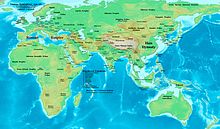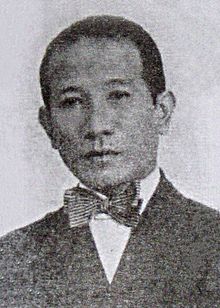Portal:Asia

 Asia (/ˈeɪʒə/ AY-zhə, UK also /ˈeɪʃə/ AY-shə) is the largest continent in the world by both land area and population. It covers an area of more than 44 million square kilometers, about 30% of Earth's total land area and 8% of Earth's total surface area. The continent, which has long been home to the majority of the human population, was the site of many of the first civilizations. Its 4.7 billion people constitute roughly 60% of the world's population. Asia shares the landmass of Eurasia with Europe, and of Afro-Eurasia with both Europe and Africa. In general terms, it is bounded on the east by the Pacific Ocean, on the south by the Indian Ocean, and on the north by the Arctic Ocean. The border of Asia with Europe is a historical and cultural construct, as there is no clear physical and geographical separation between them. A commonly accepted division places Asia to the east of the Suez Canal separating it from Africa; and to the east of the Turkish straits, the Ural Mountains and Ural River, and to the south of the Caucasus Mountains and the Caspian and Black seas, separating it from Europe. Since the concept of Asia derives from the term for the eastern region from a European perspective, Asia is the remaining vast area of Eurasia minus Europe. Therefore, Asia is a region where various independent cultures coexist rather than sharing a single culture, and the boundary between Europe is somewhat arbitrary and has moved since its first conception in classical antiquity. The division of Eurasia into two continents reflects East–West cultural differences, some of which vary on a spectrum. (Full article...) Featured articleSino-Roman relations comprised the (primarily indirect) contacts and flows of trade goods, information, and occasional travelers between the Roman Empire and the Han dynasty, as well as between the later Eastern Roman Empire and various successive Chinese dynasties that followed. These empires inched progressively closer to each other in the course of the Roman expansion into ancient Western Asia and of the simultaneous Han military incursions into Central Asia. Mutual awareness remained low, and firm knowledge about each other was limited. Surviving records document only a few attempts at direct contact. Intermediate empires such as the Parthians and Kushans, seeking to maintain control over the lucrative silk trade, inhibited direct contact between the two ancient Eurasian powers. In 97 AD, the Chinese general Ban Chao tried to send his envoy Gan Ying to Rome, but Parthians dissuaded Gan from venturing beyond the Persian Gulf. Ancient Chinese historians recorded several alleged Roman emissaries to China. The first one on record, supposedly either from the Roman emperor Antoninus Pius or from his adopted son Marcus Aurelius, arrived in 166 AD. Others are recorded as arriving in 226 and 284 AD, followed by a long hiatus until the first recorded Byzantine embassy in 643 AD. The indirect exchange of goods on land along the Silk Road and sea routes involved (for example) Chinese silk, Roman glassware and high-quality cloth. Roman coins minted from the 1st century AD onwards have been found in China, as well as a coin of Maximian (Roman emperor from 286 to 305 AD) and medallions from the reigns of Antoninus Pius (r. 138–161 AD) and Marcus Aurelius (r. 161–180 AD) in Jiaozhi (in present-day Vietnam), the same region at which Chinese sources claim the Romans first landed. Roman glassware and silverware have been discovered at Chinese archaeological sites dated to the Han period (202 BC to 220 AD). Roman coins and glass beads have also been found in the Japanese archipelago. (Full article...) Selected Country South Korea, officially the Republic of Korea (ROK), is a country in East Asia. It constitutes the southern part of the Korean Peninsula and borders North Korea along the Korean Demilitarized Zone; though it also claims the land border with China and Russia. The country's western border is formed by the Yellow Sea, while its eastern border is defined by the Sea of Japan. South Korea claims to be the sole legitimate government of the entire peninsula and adjacent islands. It has a population of 51.96 million, of which half live in the Seoul Capital Area, the ninth most populous metropolitan area in the world. Other major cities include Busan, Daegu, and Incheon. The Korean Peninsula was inhabited as early as the Lower Paleolithic period. Its first kingdom was noted in Chinese records in the early 7th century BCE. After the unification of the Three Kingdoms of Korea into Silla and Balhae in the late 7th century, Korea was ruled by the Goryeo dynasty (918–1392) and the Joseon dynasty (1392–1897). The succeeding Korean Empire (1897–1910) was annexed in 1910 into the Empire of Japan. Japanese rule ended following Japan's surrender in World War II, after which Korea was divided into two zones: a northern zone, which was occupied by the Soviet Union, and a southern zone, which was occupied by the United States. After negotiations on reunification failed, the southern zone became the Republic of Korea in August 1948, while the northern zone became the communist Democratic People's Republic of Korea the following month. (Full article...) Featured biographyAbisin Abbas (Indonesian: [aˈbisɪn aˈbas]; 26 February 1902 – 20 October 1961), better known by his pseudonym Andjar Asmara ([anˈdʒar asˈmara]), was a dramatist and filmmaker active in the cinema of the Dutch East Indies. Born in Alahan Panjang, West Sumatra, he first worked as a reporter in Batavia (modern-day Jakarta). He became a writer for the Padangsche Opera in Padang, where he developed a new, dialogue-centric style, which later spread throughout the region. After returning to Batavia in 1929, he spent over a year as a theatre and film critic. In 1930 he joined the Dardanella touring troupe as a writer. He went to India in an unsuccessful bid to film his stage play Dr Samsi. After leaving Dardanella in 1936, Andjar established his own troupe. He also worked at a publishers, writing serials based on successful films. In 1940 he was asked to join The Teng Chun's company, Java Industrial Film, helping with marketing and working as a director for two productions. After the Japanese occupation, during which time he stayed in theatre, Andjar made a brief return to cinema. He directed three films in the late 1940s and wrote four screenplays, which were produced as films in the early 1950s. He published a novel, Noesa Penida (1950). Afterward he worked for the remainder of his life writing serials based on local films and publishing film criticism. Historians recognise him as a pioneer of theatre and one of the first native Indonesian film directors, although he had little creative control of his productions. (Full article...) General imagesThe following are images from various Asia-related articles on Wikipedia. Featured picture Credit: Ggia Syrian and Iraqi refugees arrive from Turkey to Skala Sykamias, Lesbos island, Greece. Volunteers (life rescue team - with yellow-red clothes) from the Spanish NGO Proactiva Open Arms help the refugees.
Did you know...
Updated: 6:33, 14 February 2024 In the news
Related portalsMajor Religions in Asia Middle East Central Asia and Surroundings Indian Subcontinent Southeast Asia East Asia Selected panorama
Baalbek is a town in the Beqaa Valley of Lebanon situated east of the Litani River. It is famous for its exquisitely detailed yet monumentally scaled temple ruins of the Roman period, when Baalbek, then known as Heliopolis, was one of the largest sanctuaries in the Empire. TopicsCategoriesAssociated WikimediaThe following Wikimedia Foundation sister projects provide more on this subject:
More portalsShortcuts to this page: Asia portal • P:ASIA Purge server cache |































































































